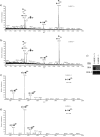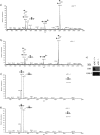Glycomic analyses of mouse models of congenital muscular dystrophy
- PMID: 21460210
- PMCID: PMC3122180
- DOI: 10.1074/jbc.M110.203281
Glycomic analyses of mouse models of congenital muscular dystrophy
Abstract
Dystroglycanopathies are a subset of congenital muscular dystrophies wherein α-dystroglycan (α-DG) is hypoglycosylated. α-DG is an extensively O-glycosylated extracellular matrix-binding protein and a key component of the dystrophin-glycoprotein complex. Previous studies have shown α-DG to be post-translationally modified by both O-GalNAc- and O-mannose-initiated glycan structures. Mutations in defined or putative glycosyltransferase genes involved in O-mannosylation are associated with a loss of ligand-binding activity of α-DG and are causal for various forms of congenital muscular dystrophy. In this study, we sought to perform glycomic analysis on brain O-linked glycan structures released from proteins of three different knock-out mouse models associated with O-mannosylation (POMGnT1, LARGE (Myd), and DAG1(-/-)). Using mass spectrometry approaches, we were able to identify nine O-mannose-initiated and 25 O-GalNAc-initiated glycan structures in wild-type littermate control mouse brains. Through our analysis, we were able to confirm that POMGnT1 is essential for the extension of all observed O-mannose glycan structures with β1,2-linked GlcNAc. Loss of LARGE expression in the Myd mouse had no observable effect on the O-mannose-initiated glycan structures characterized here. Interestingly, we also determined that similar amounts of O-mannose-initiated glycan structures are present on brain proteins from α-DG-lacking mice (DAG1) compared with wild-type mice, indicating that there must be additional proteins that are O-mannosylated in the mammalian brain. Our findings illustrate that classical β1,2-elongation and β1,6-GlcNAc branching of O-mannose glycan structures are dependent upon the POMGnT1 enzyme and that O-mannosylation is not limited solely to α-DG in the brain.
Figures




References
Publication types
MeSH terms
Substances
Grants and funding
LinkOut - more resources
Full Text Sources
Medical
Molecular Biology Databases
Miscellaneous

